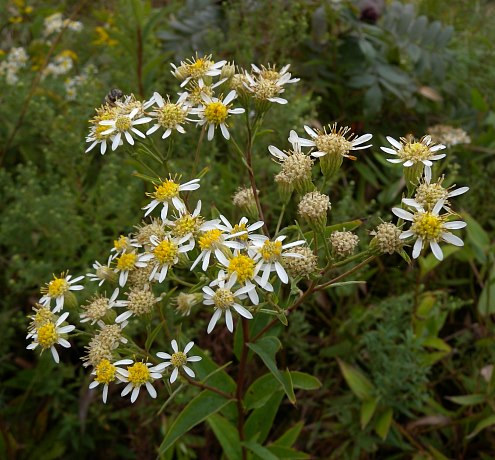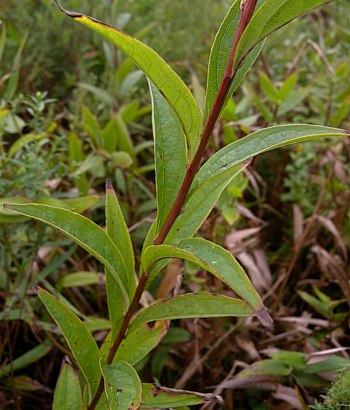
The central stem terminates in a flat-headed panicle (compound corymb) of flowerheads about 3-12" across. Individual flowerheads are about ½" across, consisting of 5-12 ray florets that surround 12-25 disk florets. The petal-like corollas of the ray florets are white; the tubular corollas of the disk florets are yellow while in bloom, but become cream-colored or dingy white thereafter. Each disk floret has 5 spreading lobes. At the base of each flowerhead, there are 2-4 series of appressed floral bracts (phyllaries) that are narrowly oblong, green, and glabrous to short-pubescent. The branches of the inflorescence are light green or yellowish brown; they are either glabrous or short-pubescent. Leafy bracts about ½-1½" long occur along these branches; they are lanceolate to narrowly elliptic. The blooming period occurs from late summer into the fall, lasting 1-2 months. Both ray and disk florets are replaced by achenes with whitish tufts of hair. In each tuft of hair, the outermost hairs are bristly and short (less than 1 mm. in length), while the inner hairs are longer (3-6 mm. in length). Individual achenes are about 3 mm. (1/8") long, bullet-shaped, and sparsely short-pubescent. They are distributed by the wind. The root system is fibrous and rhizomatous. Occasionally, small colonies are formed from vegetative offsets.
Cultivation: The preference is full or partial sun, slightly wet to moist conditions, and calcareous soil that contains sandy-loam. The pH should be slightly acidic. This wildflower can adapt to other kinds of soil, although they are not preferred.
Range & Habitat: The native Flat-Topped Aster is occasional in NE Illinois and parts of central Illinois, while in the rest of the state it is uncommon or absent. Habitats include wet to moist sand prairies, moist sandy thickets, soggy meadows and openings in wooded areas, interdunal sloughs and swales near Lake Michigan, fens, and seeps. This wildflower is found in higher quality wetlands that are often sandy and calcareous.
Faunal Associations: The nectar and pollen of the flowerheads attract honeybees, bumblebees, little carpenter bees (Ceratina spp.), long-horned bees (Melissodes spp.), leaf-cutting bees (Megachile spp.), cuckoo leaf-cutting bees (Coelioxys spp.), Halictid bees, Andrenine bees, dagger bees (Perdita spp., Pseudopanurgus spp.), Sphecid wasps, Tiphiid wasps, Eumenine wasps, paper wasps (Polistes spp.), hornets (Dolichovespula spp., Vespula spp.), ants, Syrphid flies, bee flies (Bombyliidae), skippers, and beetles (Grundel et al., 2011; Wilhelm & Rericha, 2017). Oligolectic bees (specialist pollinators) that have been observed to visit Flat-topped Aster (Doellingeria umbellata), are Andrena nubecula, Andrena placata, Perdita octomaculata, and Pseudopanurgus andrenoides. The foliage, plant sap, roots, and other parts of Flat-topped Aster and other asters are eaten by such insects as leaf beetles, weevils, larvae of tumbling flower beetles, larvae of leaf-miner flies, larvae of gall flies, larvae of fruit flies, plant bugs, aphids, leafhoppers, armored scales, mealybugs, larvae of moths, larvae of crescent and checkerspot butterflies (Phyciodes spp., Chlosyne spp.), and grasshoppers. Flat-topped Aster is the primary host plant of the butterfly, Harris' Checkerspot (Chlosyne harrisii). The Insect Table has a more detailed list of these insect feeders. The seeds of asters are eaten by the American Tree Sparrow, while the Ruffed Grouse feeds on both the leaves and seeds (Martin et al., 1951/1961). Hoofed mammalian herbivores frequently browse on these plants, particularly the less hairy species. These species include Elk, White-tailed Deer, cattle, and other domesticated grazers (Schneider et a., 2006; personal observations).
Photographic Location: A wet sand prairie at the Indiana Dunes National Lakeshore in NW Indiana.

Comments: Flat-Topped Aster is an attractive wildflower that favors relatively open areas that are damp and sandy. Because of its flat-topped inflorescence, it is relatively easy to distinguish from other asters (Aster spp.) within the state. In particular, the prominent disk florets of the flowerheads are somewhat unusual in that they become dingy white or cream-colored shortly after they bloom, rather than orange-red or purple. The reason Flat-Topped Aster has been assigned to the Doellingeria genus is related to the different hair lengths of its tufted achenes: the outer hairs are less than 1 mm. in length, while the inner hairs are 3-6 mm. in length. Usually, asters have a uniform length for the hairs of their tufted achenes. An older scientific name of Flat-Topped Aster is Aster umbellatus.